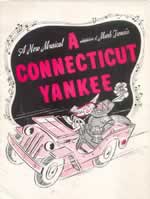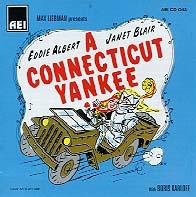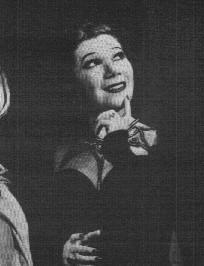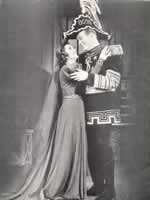A Connecticut Yankee, 1943 Revival
 |
- Here's Martin The Groom
- This Is My Night to Howl
- To Keep My Love Alive
- Ye Lunchtime Follies
- Can't You Do a Friend a Favor?
- You Always Love the Same Girl
- The Camelot Samba
- Elaine (Dropped after the New York opening)
- I Won't sing a song (Dropped after the New York opening)
- My heart stood still
- Thou Swell
- At the Round Table
- On a Desert Island With Thee
- I Feel at Home With You
- Hymm To The Sun
Music by Richard Rodgers
Produced by ??
Book by Herbert Fields
Directed by John C. Wilson
Choreoghraphy William Holbrook and Al White Jr.
Starring: Vivienne Segal, Dick Foran, Vera-Ellen and Westmyr Rhole
It ran for 135 performances.
This was Lorenz Hart's last score.
 |
The story opened with a prologue, in which Martin (the Yankee) is visitinghis former fiancée, Alice Carter, on the eve of his marriage to Fay Morgan.Discovering them together, Fay knocks Martin out with a champagne bottle;while he is unconscious, Martin dreams he is back in Camelot in the days Of King Arthur. He falls in love with Demoiselle Alisande Le Carteloise (a.k.a. Sandy), "a damosel who's as dumbas'ell - but sweet". Dubbed "Sir Boss", he is in put in charge to industrializing the country. Working on a percentage basis, Sir Boss creates a one-man revolution by introducing telephones, advertising and radio to the astonished Knights of the Round Table. The King's evil sister Morgana Le Fay , has Alisande Kidnapped, but Sir Boss rescues her just before awakening. Back in the present day, he realizes it is Alice not Fay, whom he really loves.
With Vivienne Segal set from the start, Rodgers
and Hart found their new Sir Boss in the form of senator's son Dick (actually
John Nicholas) Foran, a former band vocalist turned low-budget singing
movie cowboy and journey-man actor. Their new Alisande was Julie Warren;
Arthur, Robert Chisholm, Evelyn was played by Vera-Ellen, real name Vera-Ellen
Westmyr Rhole, a lithe youngster who'd started dancing at age ten, performed
as a Radio City Rockette, and most recently sparkled in By Jupiter.
Rehearsals were scheduled for mid-September.
A copy still exists of Larry' s handwritten
draft for the second act, full, like the new lyrics, of good jokes and
topical allusions. Merlin was informed that his "weather prophecy"
had a low Crossley rating (the name of a radio-audience-survey); the "in"
place to drink was the "Connecticut Yankee Clippee" heroine Sandy
organizes the Camelot International Objectors, a women's protest group
that just coincidentally has the same initials as John L. Lewis's mighty
steel union.
 |
Taking his cue from a series of forty-five-minute
American Theater Wing productions supervised by Kurt Weill that had been
staged at the Todd Shipyard in Brooklyn in June 1942 (which might suggest
where Larry spent at least some of his time) under the catch-all title
Lunchtime Follies, he introduced a radio program for the factory
workers of Camelot, "Ye Lunchtime Follies "
which even had its own "crooner" singing deliberately, deliciously unadulterated
corn to sweet "Elaine" who he loved when they met in the rain. And the
girls in the factory would shriek and "swoon" like Frank Sinatra's bobby-soxers.
The song appears to have been cut from the finished score, as was another lyric that has escaped all the collectors who have scoured the archived in search of unpublished gems by Lorenz Hart; "I Won't Sing A Song" was written for Vivienne Segal as Morgan Le Fay to sing to Sir Boss in the first scene of Act Two. No melody seems to have been written, and charming though it is, the song was never used.
They retained the best numbers from the I927
production, of course "On A Desert Island With Thee,"
"I Feel At Home With You" "Thou
Swell" and "My Heart Stood Still." The
new songs, too, were good: "This is my Night To Howl"
"The Camelot Samba" (capitalizing on a current craze), "You
Always Love The Same Girl" and the haunting, touching "Can't
You Do A Friend A Favor?" which was written during rehearsals. And
brilliantly demonstrating that, no matter what his problems, he had not
lost his lyrical touch is the song Larry wrote especially for Vivienne
Segal, in which the much-married Queen describes how she "bumped off"
her many husbands "To Keep My Love Alive."
Taking her through it at rehearsal, Larry suggested that at the end of each refrain, on the word "alive" she take it a half-tone lower. For a soprano this was, to say the least, unusual. As with each refrain she sank further down the scale, Vivienne balked.
During the 1943-44 season, composer Richard Rodgers had two shows running
on Broadway at the same time. Nothing unusual there (a decade later, Rodgers
would have four shows playing in New York simultaneously), except that
these two titles represented transitional landmarks. From November of
'43 until March of '44, with A CONNECTICUT YANKEE at the Martin Beck Theatre
joining OKLAHOMA! at the St. James, Broadway hosted the first Rodgers
& Hammerstein musical, and the last Rodgers & Hart musical, at the same
time.
The team of composer Richard Rodgers and lyricist Lorenz Hart began in
the 'teens, and really took off in the mid '20s. Like the shows they wrote,
Rodgers & Hart sported an irrepressible outlook, a sunny air that masked
an almost mischevious subversion to the rules. With glee, they knocked
down Broadway conventions, and came up with hit after hit. With panache,
they wrote show tunes that swept the nation, and landed on the cover of
Time Magazine. Theirs was a professional partnership founded in friendship,
a friendship that flourished in their profession.
One of their earliest hits was a rollicking musical comedy based on Mark Twain's satirical time-travel novel, A CONNECTICUT YANKEE IN KING ARTHUR'S COURT, co-written with their frequent early collaborator, Herb Fields. Part of what drew them to YANKEE was the chance it gave Rodgers & Hart to utilize their trademark mix of modern vernacular with classical references. (Other notable examples being DEAREST ENEMY [1925], which laced its saga of the American Revolution with a '20s sophistication, and THE BOYS FROM SYRACUSE [1938] and BY JUPITER [1942], both of which were utterly modern while steeped in classic literature of the ancient world.)
With A CONNECTICUT YANKEE, Rodgers & Hart could match Mark Twain tone-for-tone, giving his Camelot their unique Gotham-makeover, treating the Round Table in King Arthur's Court like the Round Table at the Algonquin Hotel. The result was a cocktail blend of martini and meade, detectable in such songs as "Thou Swell, Thou Witty," "On a Desert Island With Thee," and "At the Round Table."
(The score's most romantic number, "My Heart Stood Still," was actually written for a London revue, ONE DAM THING AFTER ANOTHER, which opened in May of '27; introduced there by Jesse Matthews, it was an instant sensation. When Bea Lillie, for whom Rodgers & Hart had been hired to write a Broadway score after YANKEE, wanted to feature "My Heart Stood Still" in her new show, the duo balked. They did not want a comedienne to introduce New York to their tender ballad, and so took it out of play by telling her it was slated for a spot in YANKEE -- where it has stayed ever since.)
Opening to rave reviews on November 3, 1927, A CONNECTICUT YANKEE became
Rodgers & Hart's biggest hit to date, its run of 418 performances making
it their longest running Broadway show until BY
JUPITER surpassed it 15 years later. Overnight, Rodgers & Hart were
catapulted from Broadway up-and-comers to bona fide heavyweights.
After spending the early '30s exiled to Hollywood, like most of Broadway fleeing Depression-era fall-out, the team bounced back to New York with a string of fabled hits from 1935 to 1942: JUMBO, ON YOUR TOES, BABES IN ARMS, I'D RATHER BE RIGHT, I MARRIED AN ANGEL, THE BOYS FROM SYRACUSE, HIGHER AND HIGHER, PAL JOEY and BY JUPITER.
Success, however, was taking its toll. Rodgers, ever the family man and career maverick, had a hard time keeping Hart on course, and on focus. Hart had his personal battles to contend with, from alcoholism to an inate, self-despair. He was slowly destroying himself and, by the early '40s, it was clear that he was destroying the partnership too.
 |
Desperate, Rodgers turned for help, and found it in a former college acquaintance, a friend of his older brother's named Oscar Hammerstein II. Hammerstein quietly but unselfishly urged Rodgers to continue working with Hart while assuring Rodgers that he, Hammerstein, would be there if Rodgers ever needed him to step in, even anonymously. Hammerstein further proposed that, when the time was right, he and Rodgers should write a show together
That opportunity arose in 1942, when the Theatre Guild asked Rodgers & Hart to musicalize their play, GREEN GROWN THE LILACS, and Hammerstein was invited to write the book. But a short time thereafter, Hart dropped out; cowboy fringe and gingham weren't for him. Hammerstein took over the lyric-writing as well and Rodgers, for the first time in his professional career, wrote a Broadway show without Hart. Out of this rupture came not only an extraordinary theatrical achievement, but also the birth of the Rodgers & Hammerstein partnership.
In the immediate aftermath of OKLAHOMA!'s Broadway bow on March 31, 1943, it was evident Rodgers & Hammerstein would work together again soon. But in the meantime, each man had other outstanding commitments: Hammerstein had CARMEN JONES (his all-black version of Bizet's opera that Billy Rose was to produce that winter), and Rodgers had Hart One day in late spring '43, Rodgers was invited by a colleague at Warner Brothers to a screening of a new film starring Frederic March: THE ADVENTURES OF MARK TWAIN. In a November '43 New York Times article, Rodgers explained what happened next. "What I saw excited and touched me so that when the lights went up in the little projection room, my throat was choked with emotion and my eyes blurred with involuntary tears. I thought it would be one smart idea to put YANKEE on the stage again."
What Rodgers had been seeking was, in essence, work therapy for his long-suffering partner. His dilemma had been finding just the right project: with no task to occupy him, Hart would be a ticking time-bomb while a new show might put him under too much pressure. Jolted by his sudden flashback to A CONNECTICUT YANKEE, Rodgers hit upon the solution: if Hart were to rewrite an old hit, and with old friends like Rodgers and Herb Fields alongside him, he could stay focused and confident. Decades before Broadway purists would shudder at the term "revisical," a revisical is exactly what Richard Rodgers had in mind
At this time, Larry Hart was in an especially fragile state; on the personal front, his beloved mother had just died, and professionally, the stage project he had tried to generate while Rodgers was working with Hammerstein -- an operetta with composer Emmerich Kalman -- had fallen apart. YANKEE, at least in the short term, appeared to be the lifeline for Hart that Rodgers was hoping for The revisions toYANKEE took place over the summer of '43. "Larry behaved beautifully during the months we spent preparing the show," Rodgers recalled in his autobiography, Musical Stages. "He would come up to stay at our place in Connecticut and we'd work regularly at reasonable hours. There was no question that he was making a genuine effort to rehabilitate himself, and to prove that the team of Rodgers and Hart was still a going concern."
Dialogue was overhauled, the storyline retooled. The plot's framing device, already a departure from Twain in the '27 version, was revised yet again, this time placed in a topical, war-time setting. The cheeky show art -- which depicted a handsome knight and his besotted damsel zooming along in an Army jeep -- summed up the spirit of this modernized YANKEE. With the storyline retooled and the dialogue overhauled, several of the characters were given makeovers as well. The most significant change was done to King Arthur's wicked sister, Morgan LeFay; a non-singing role in '27, she was now turned into a singing sorceress, a bad-girls-have-more-fun anti-heroine, perfectly suited to the particular talents of Vivienne Segal. One of Broadway's most glamorous stars in its most glamorous heyday, Segal had already given memorable performances for Rodgers & Hart in I MARRIED AN ANGEL (1938) and PAL JOEY (1940), where the character of Vera Simpson, created for her, sported her initials in tribute. For Segal, whom he had loved for years and reportedly even proposed to on several occasions, Hart wrote a lyric (believed to be his very last) as wickedly witty and as showstoppingly perfect as any he ever wrote: "To Keep My Love Alive."
In October of 1943, the revised CONNECTICUT YANKEE gave its world premiere in Philadelphia. Coincidentally, Hammerstein's CARMEN JONES was trying out in the same city at the same time; in her book, Thou Swell, Thou Witty, Hart's sister-in-law Dorothy recalled a heartbreaking moment when she and Larry, walking through their hotel lobby, ran into Hammerstein. "The contrast between the dignified Hammerstein," she wrote, "and Larry's pathetic demeanor appeared to penetrate even Larry's befuddled mind. He seemed to cringe..." For Hart had been sliding into his old ways. With his work on YANKEE completed, Hart suffered a relapse; the less he was needed at the show, it seemed, the more trouble he got into elsewhere. Though Hart voiced optimism about the future (and even confided to Dorothy that he was reading Fieldings' novel TOM JONES in the hopes that it would serve as the basis for the next Rodgers & Hart show), his actions spoke otherwise November 17, 1943: opening night of A CONNECTICUT YANKEE on Broadway.
It was, by all accounts, Larry Hart's final, public struggle with himself, a night where he succumbed to his personal demons. "This wasn't an opening," Dorothy Hart wrote sadly. "It was the end of a man." Hart, without a ticket, crashed his own Broadway premiere. Disoriented and disheveled, he created enough of a disturbance at the back of the theatre that his producer and partner, Richard Rodgers, had to order him removed from the premises. Already ill at the time, within days he developed pneumonia. On November 22, 1943, five days after YANKEE opened, Lorenz Hart died The Broadway show he left behind, however, has proven a fitting tribute to the lyrical genius of Lorenz Hart. By uniting the talents of its two different-aged Harts, the revised YANKEE reminds us of the strengths of both sides of Larry Hart -- the swell, and the witty.
Carried aloft by a young and impish Hart -- heard in the sparkle of "Thou Swell," the innocence of "My Heart Stood Still" -- the score is seasoned by the depth of a wiser Hart, the master craftsman behind "To Keep My Love Alive" and "You Always Love the Same Girl." As for Richard Rodgers, we already know that A CONNECTICUT YANKEE was a labor of love, born out of compassion for his partner and friend. But Rodgers also held an affection for the show itself. For the man who, in 1943, was about to embark on a new and profound phase in his career, YANKEE marked a final nostalgic throwback, one last fling with youth. In his New York Times essay, Rodgers compared the experience of revisiting his old show to that of running into an old flame: "How does our old girl look to us? Well, she has a lot of new clothes, and there's a distinct 1943 rhythm to her walk. She goes in for jive talk occasionally, but in her more sentimental moments she still sings 'My Heart Stood Still' and when the sun comes up at the end of the eclipse scene, we see that same warm smile. It's a good feeling."
© 2000 by Bert Fink for The Rodgers & Hammerstein Organization. All Rights Reserved.
None
Sheet music:
Cds: